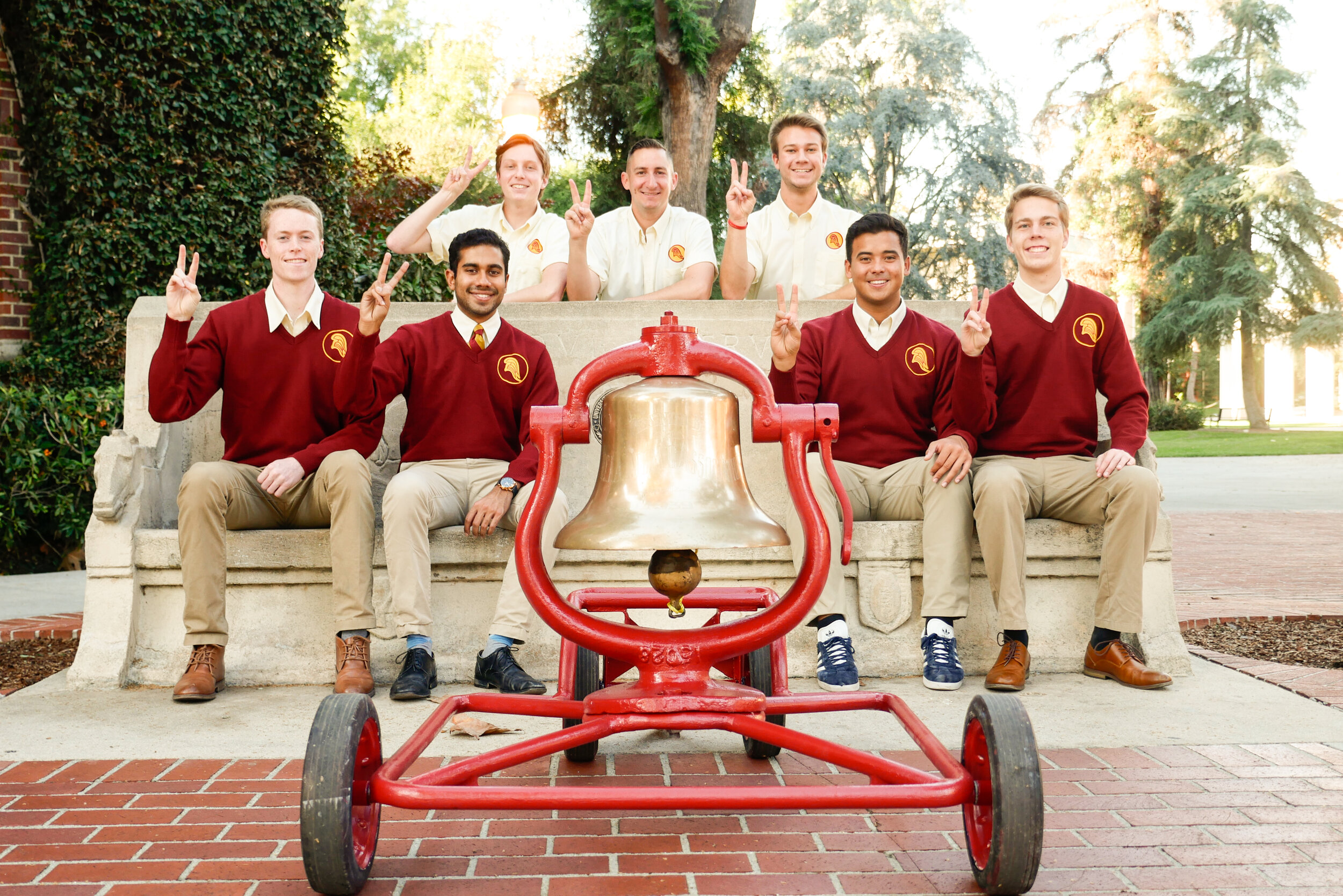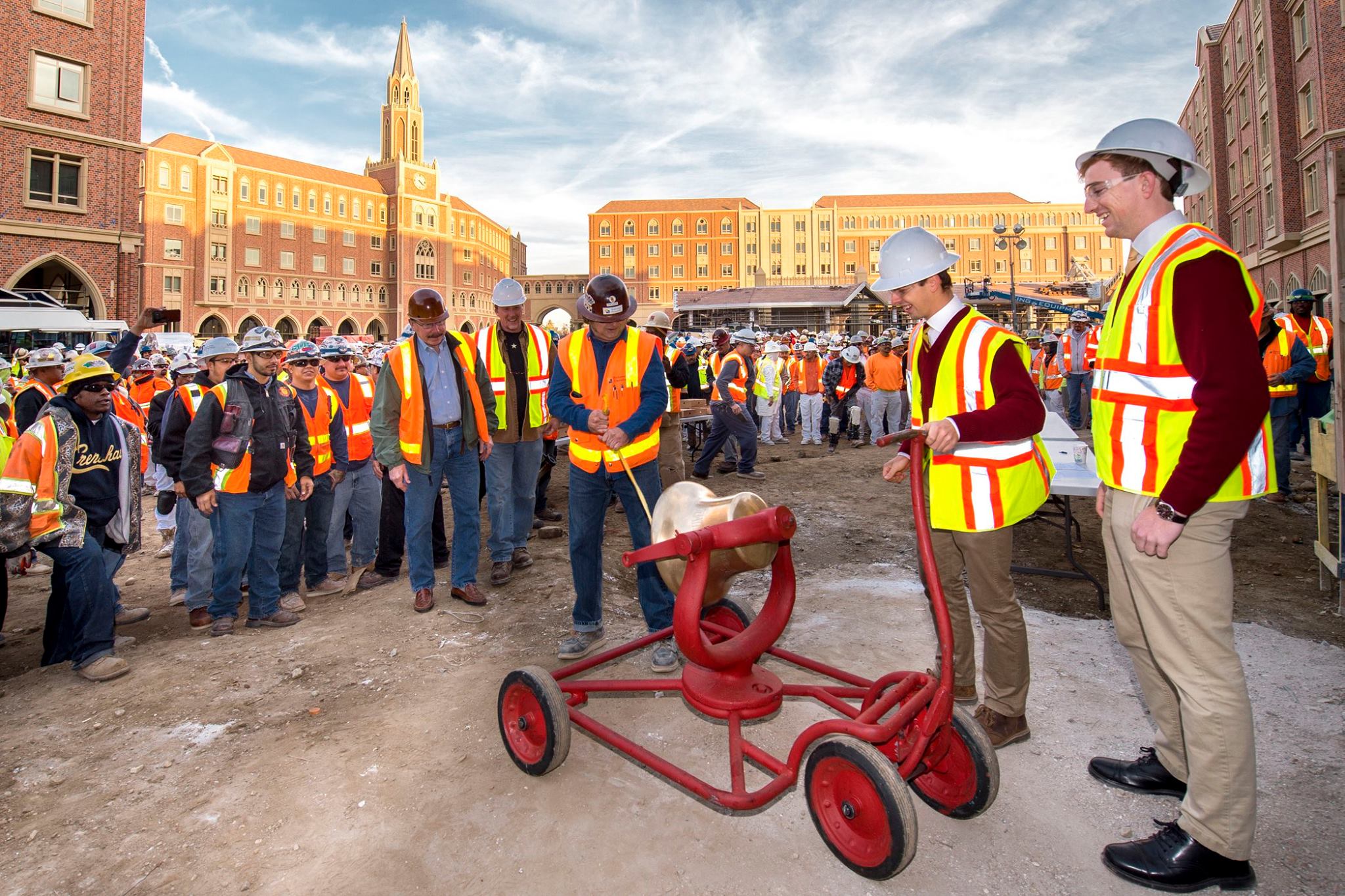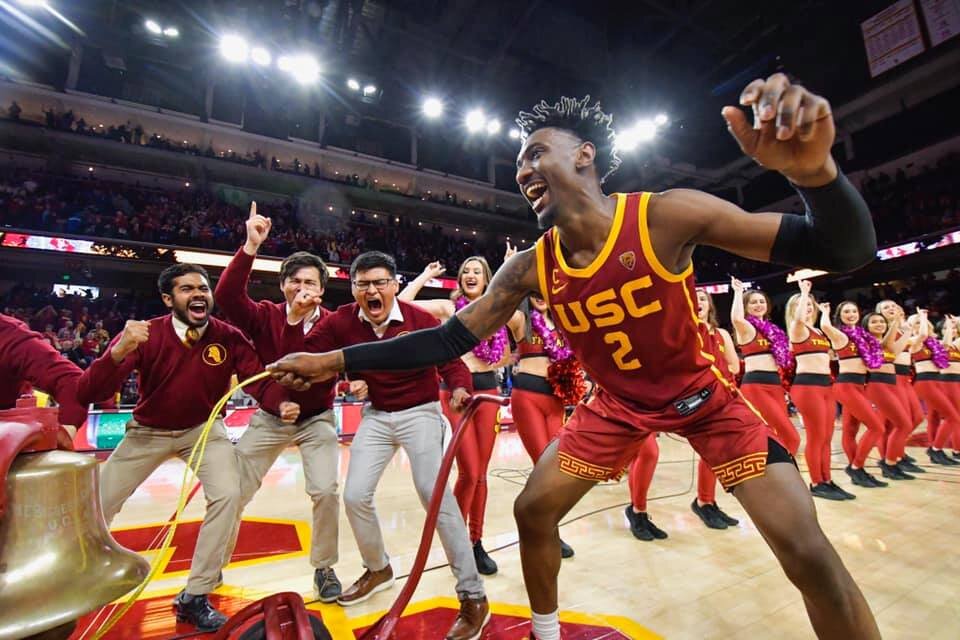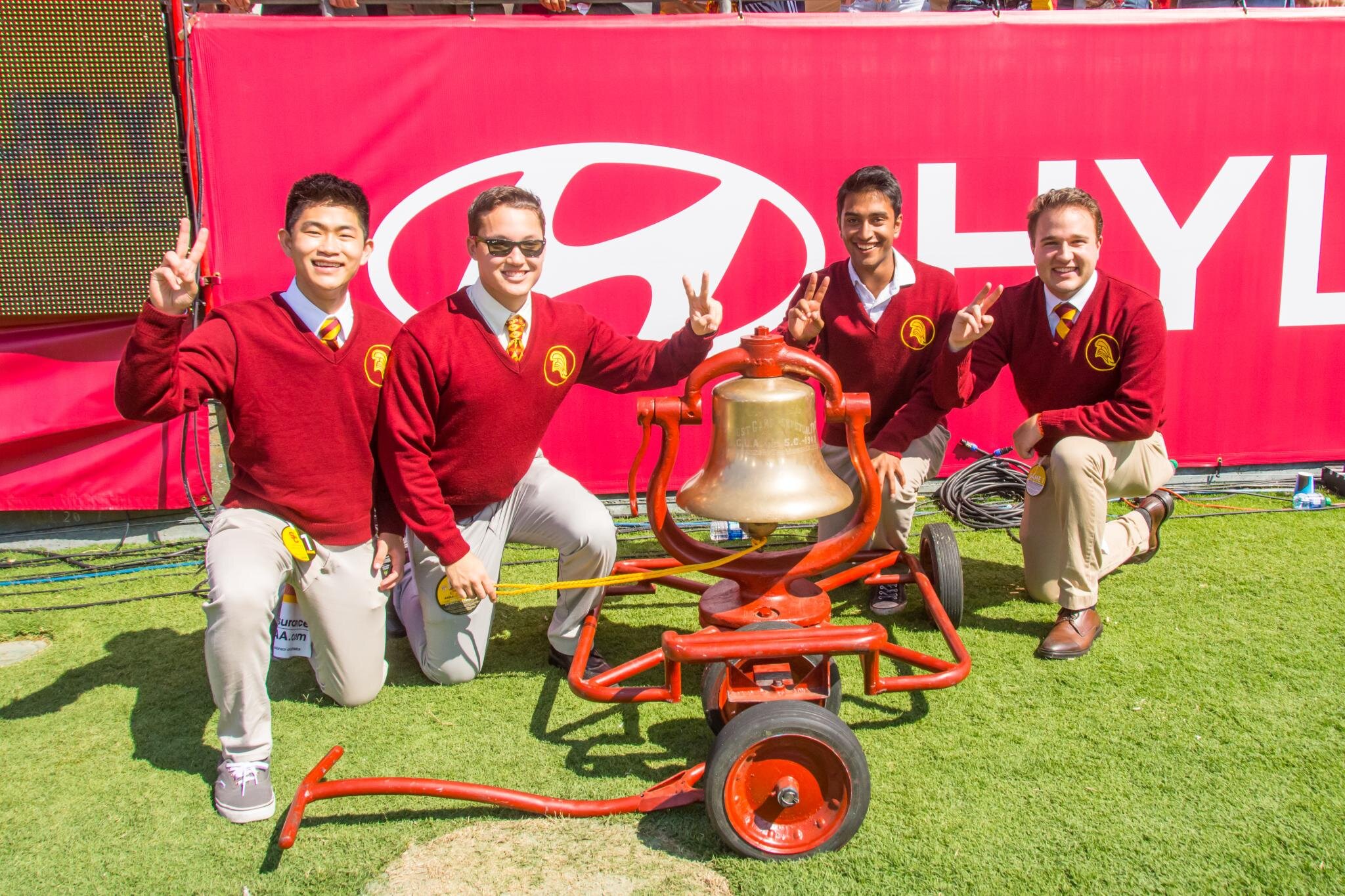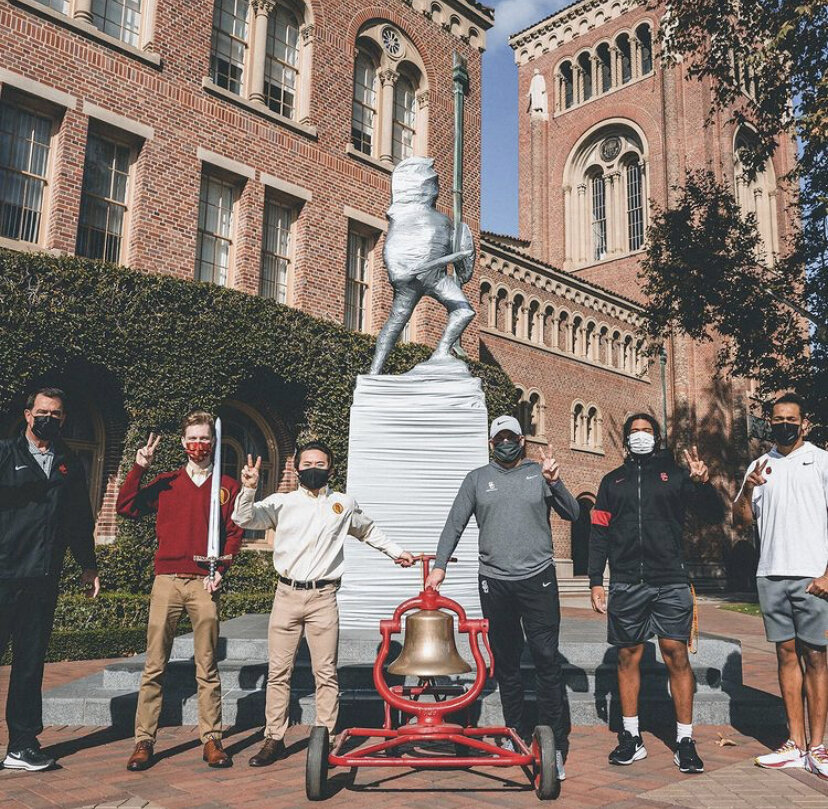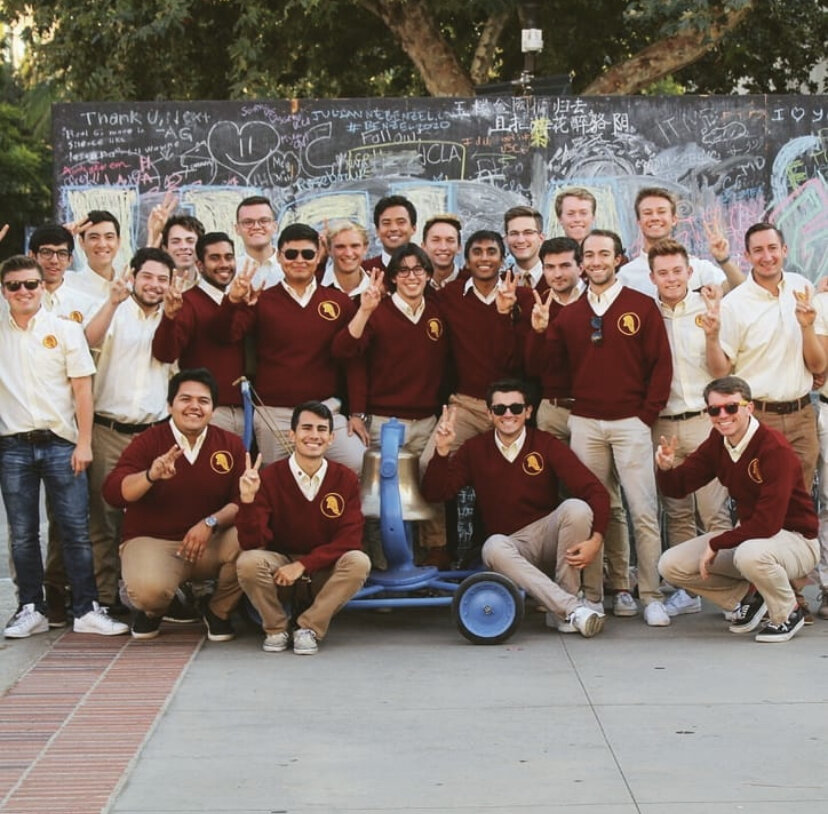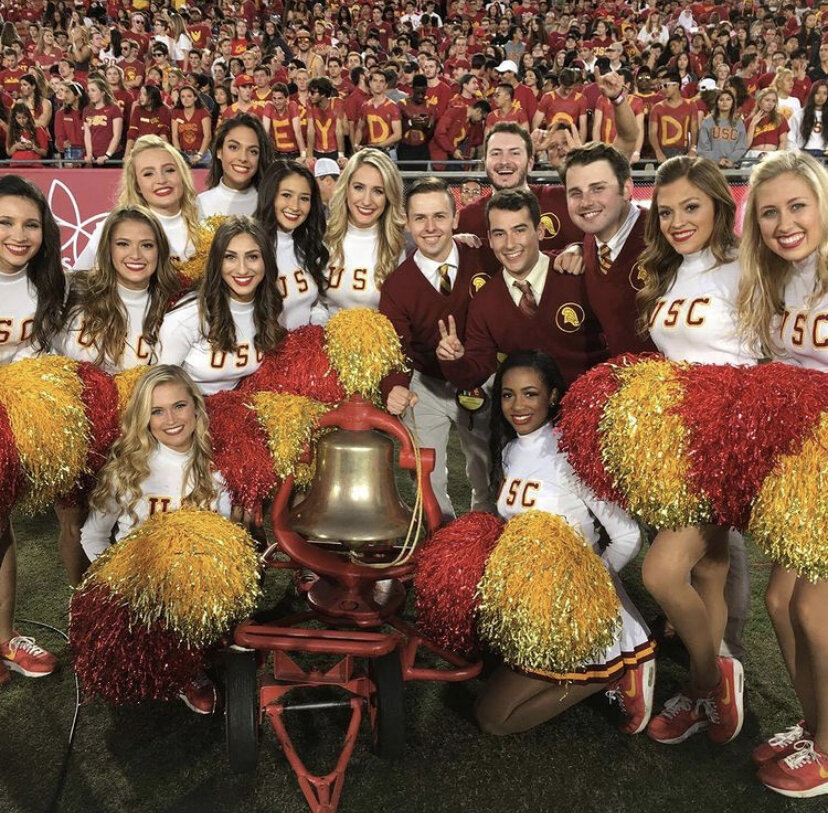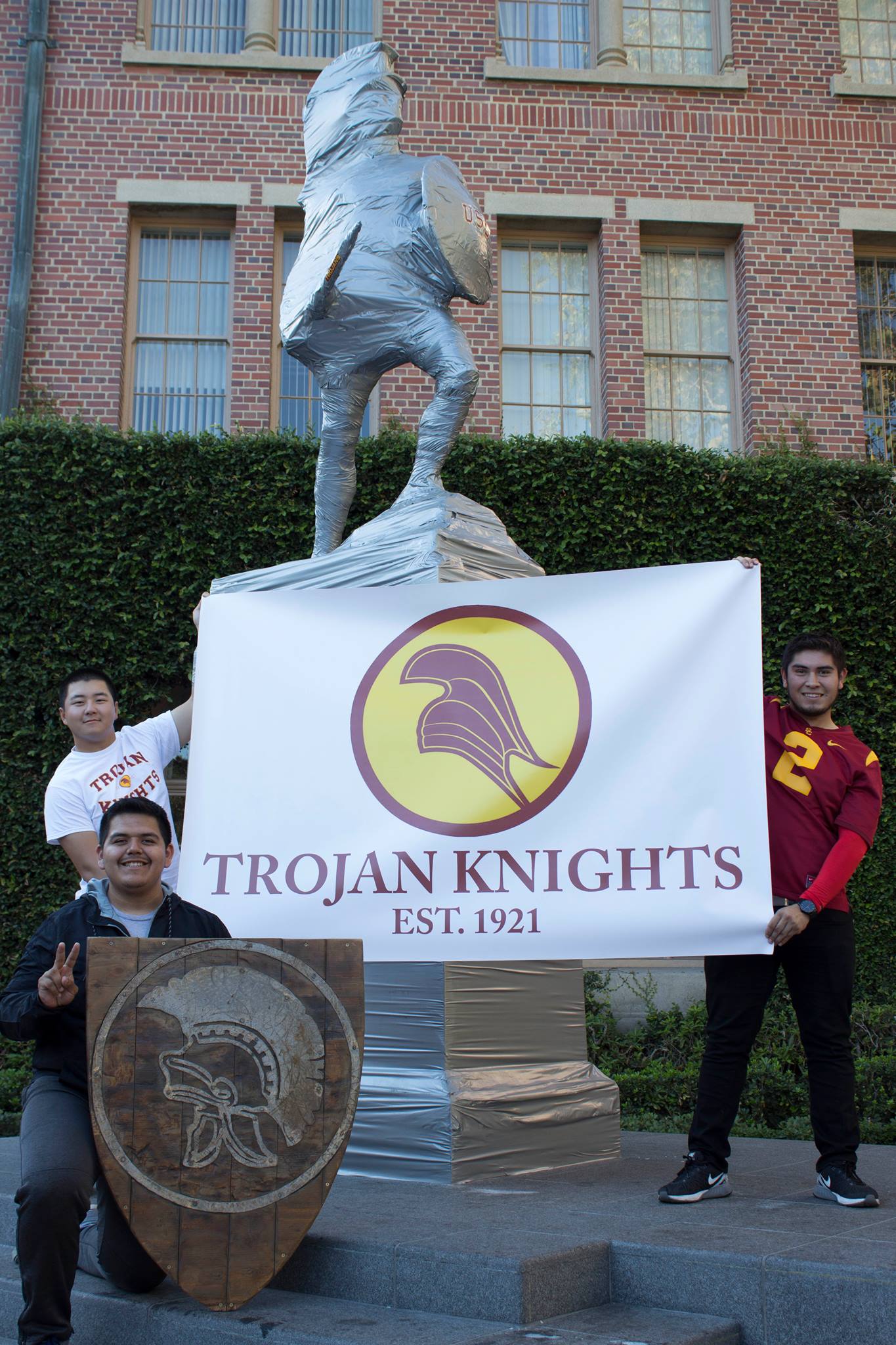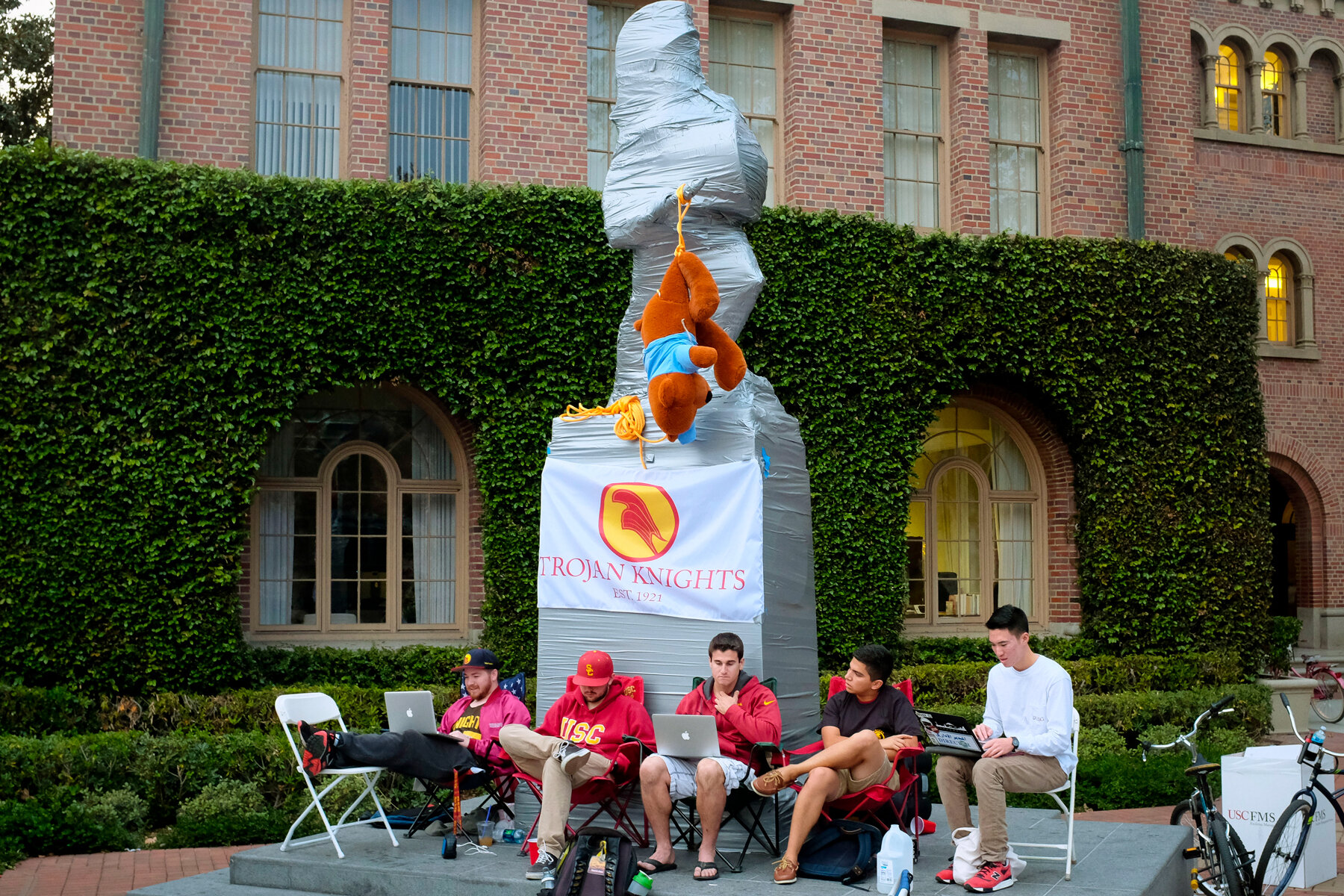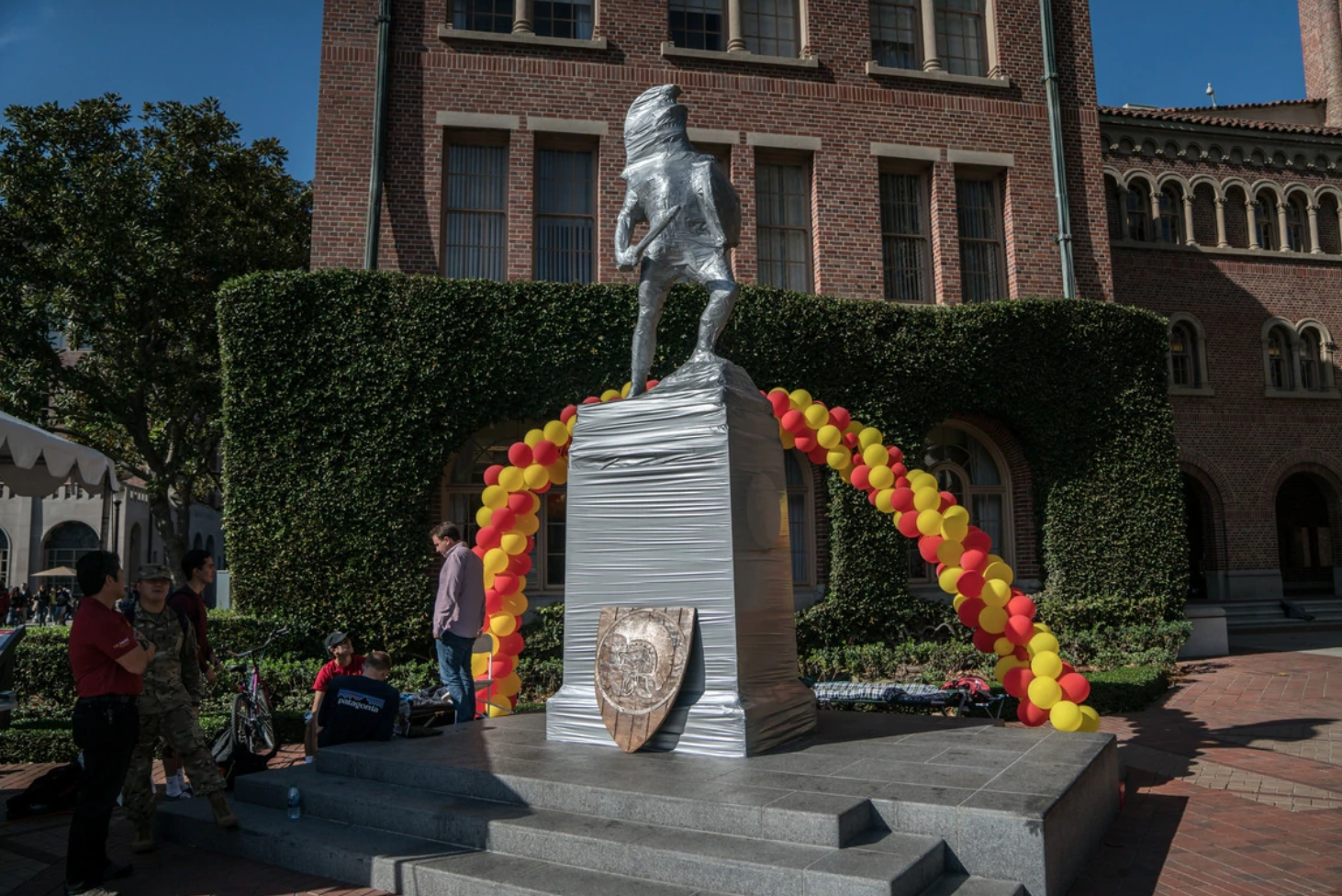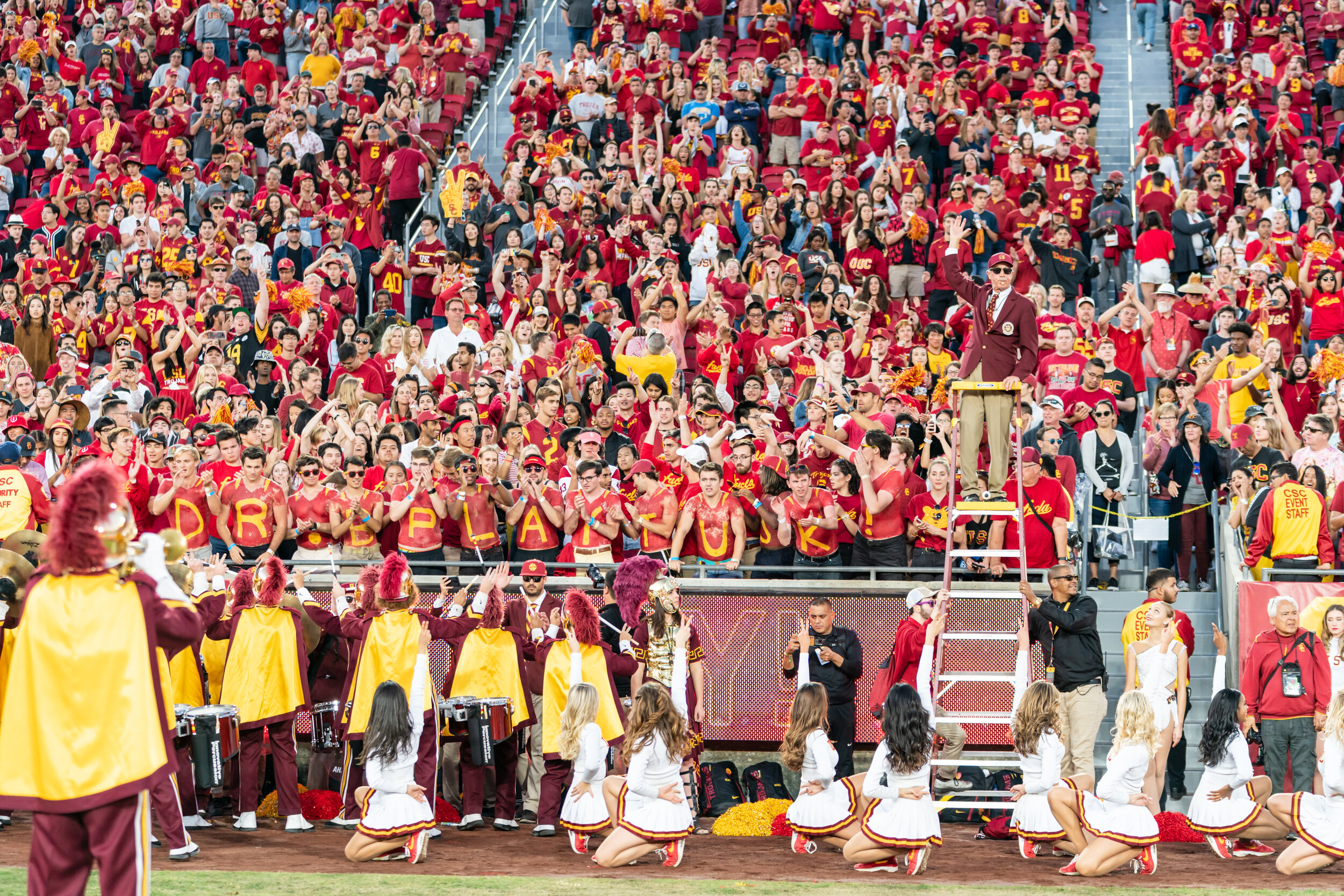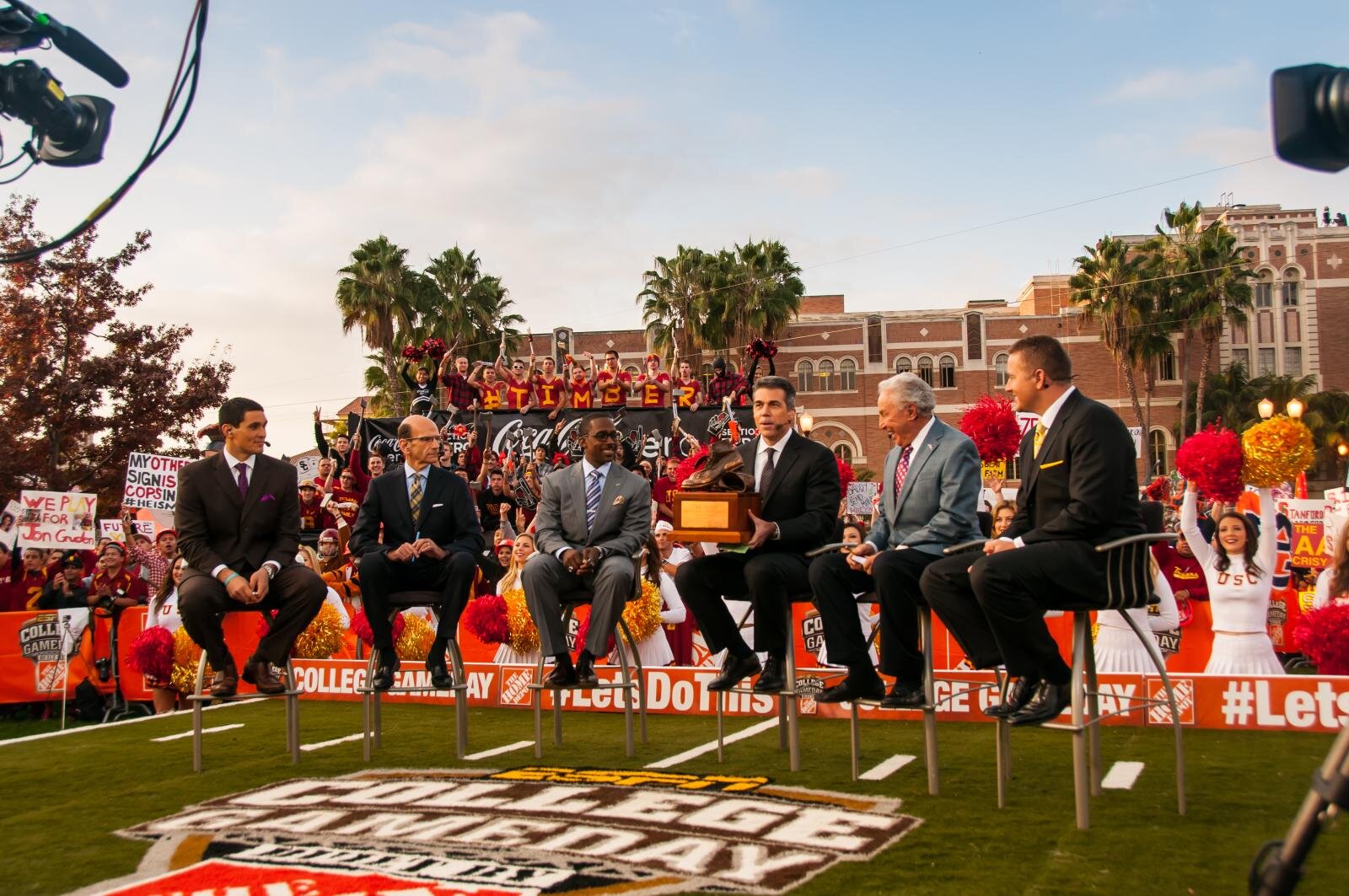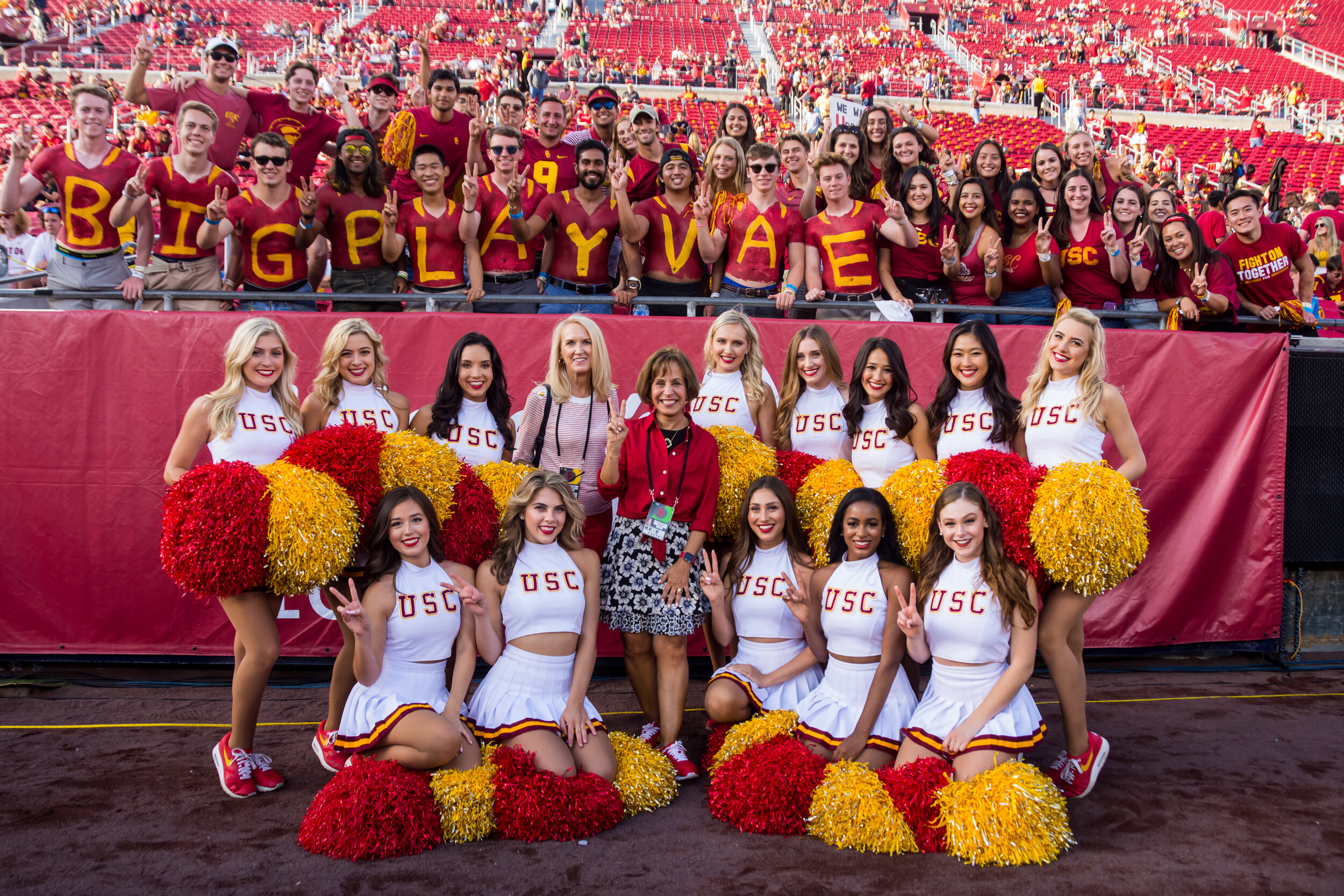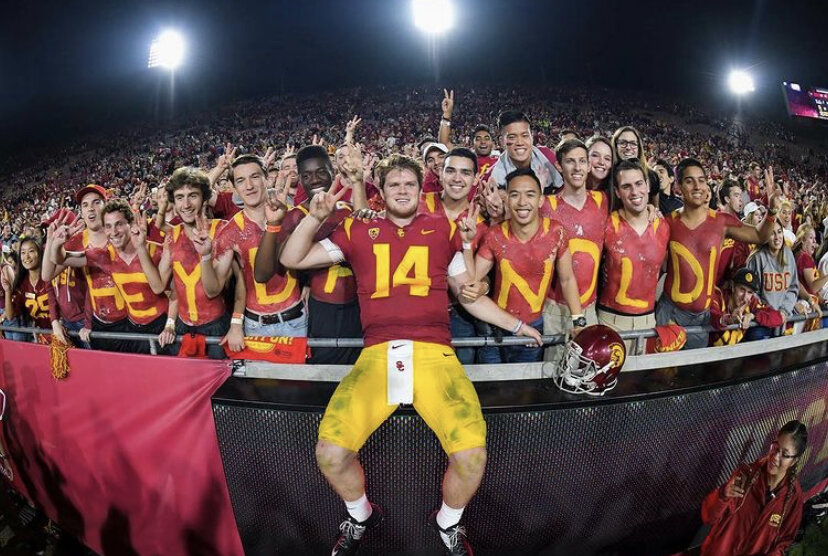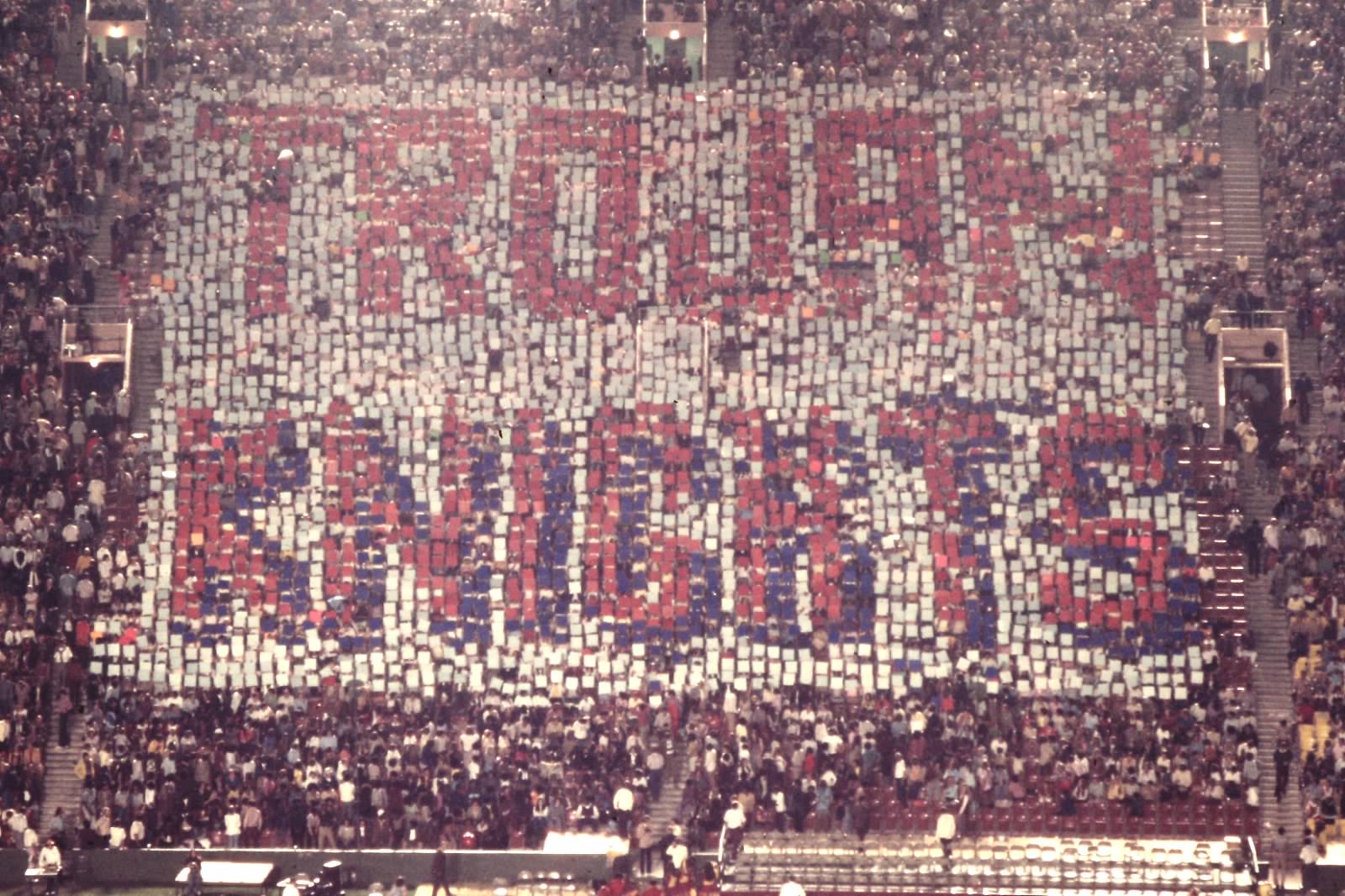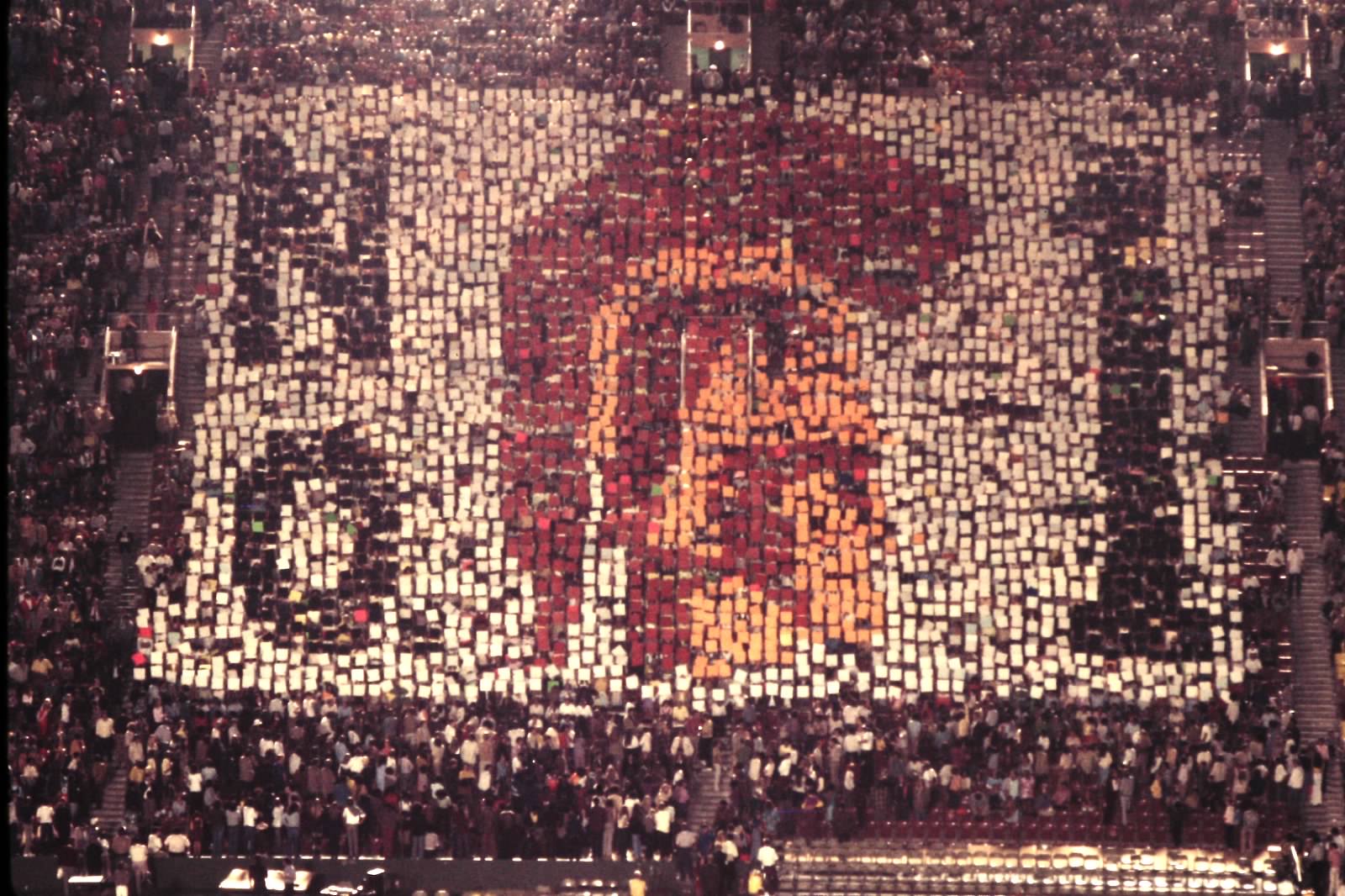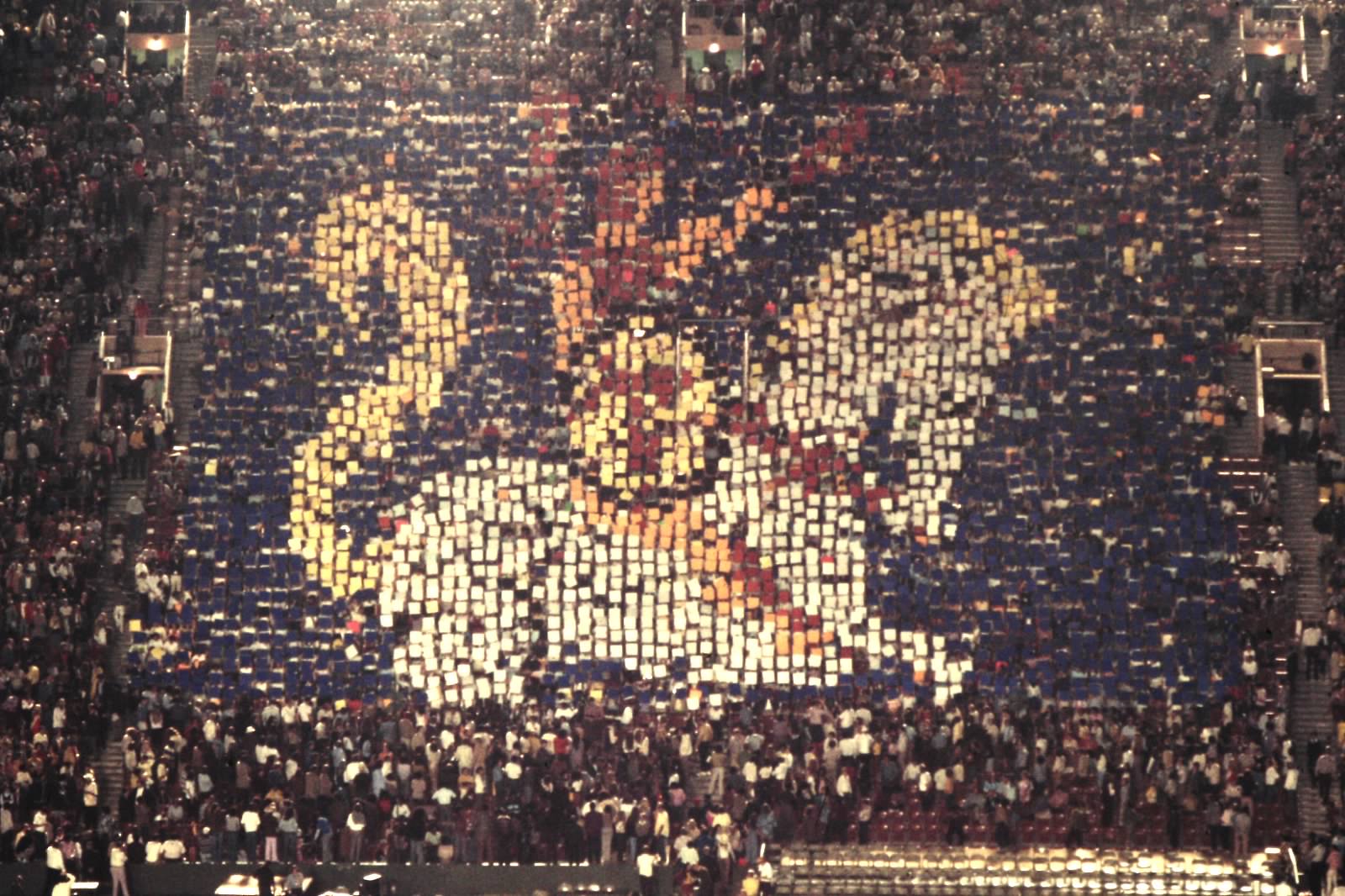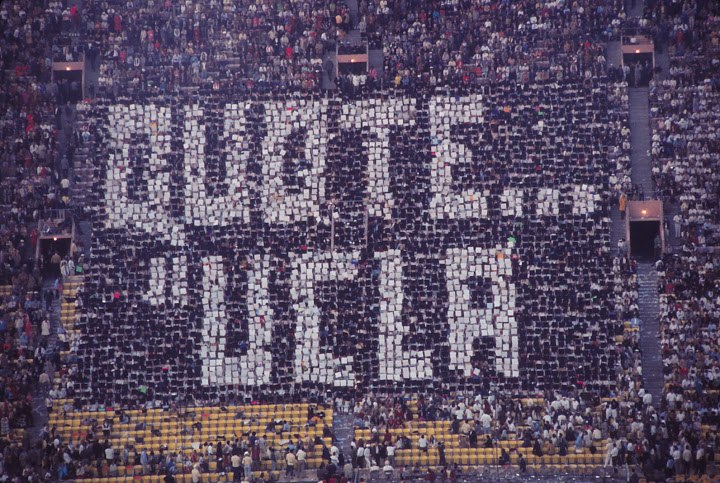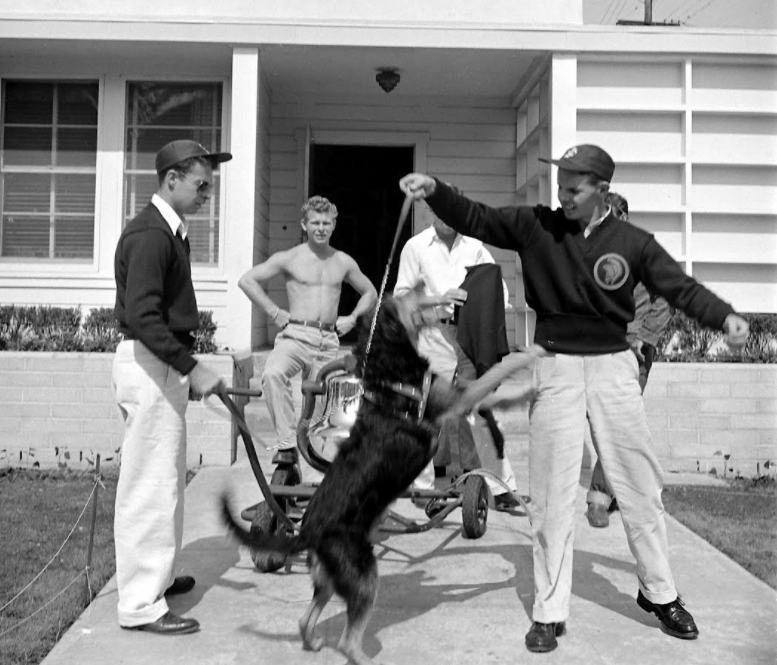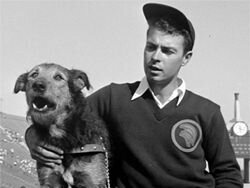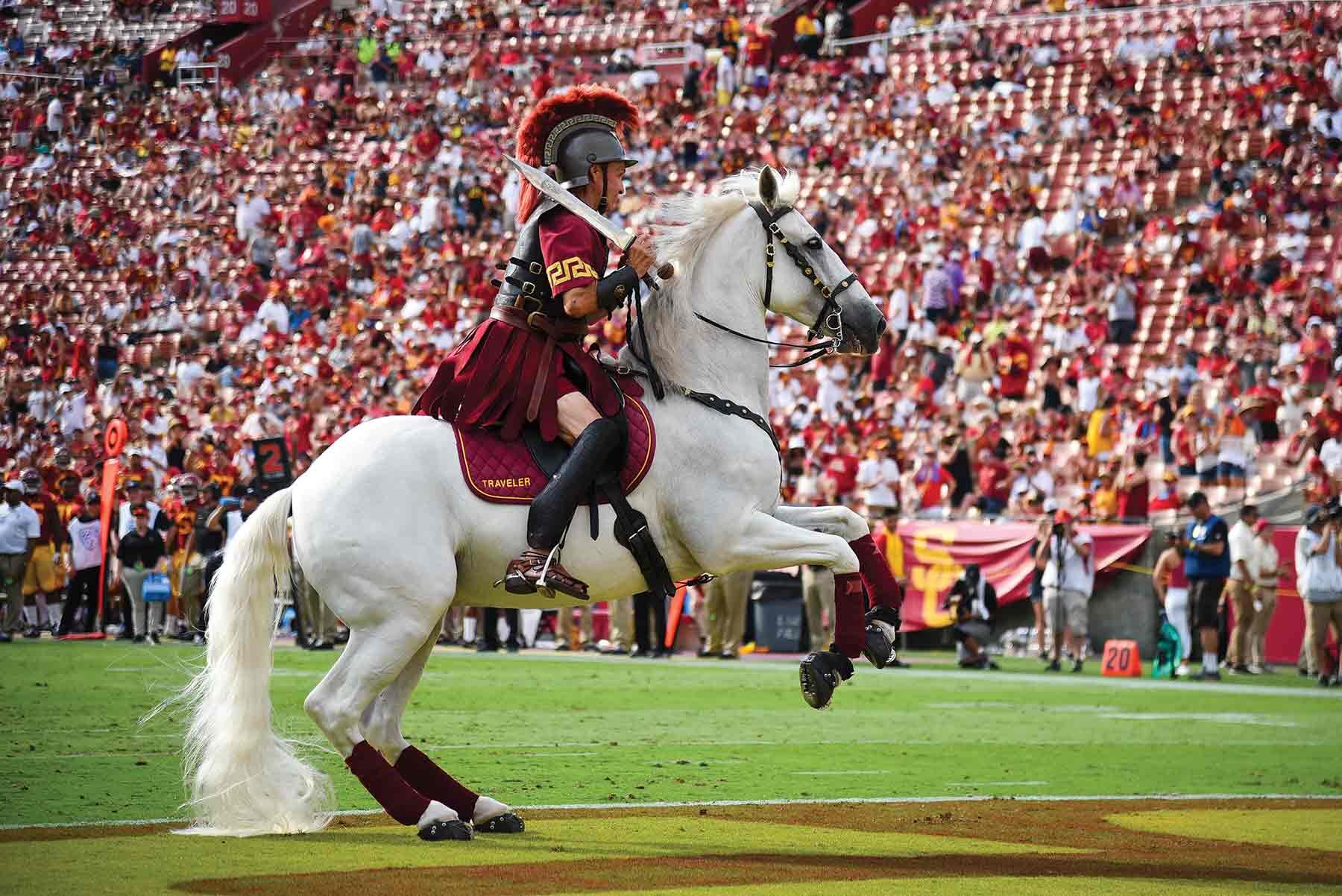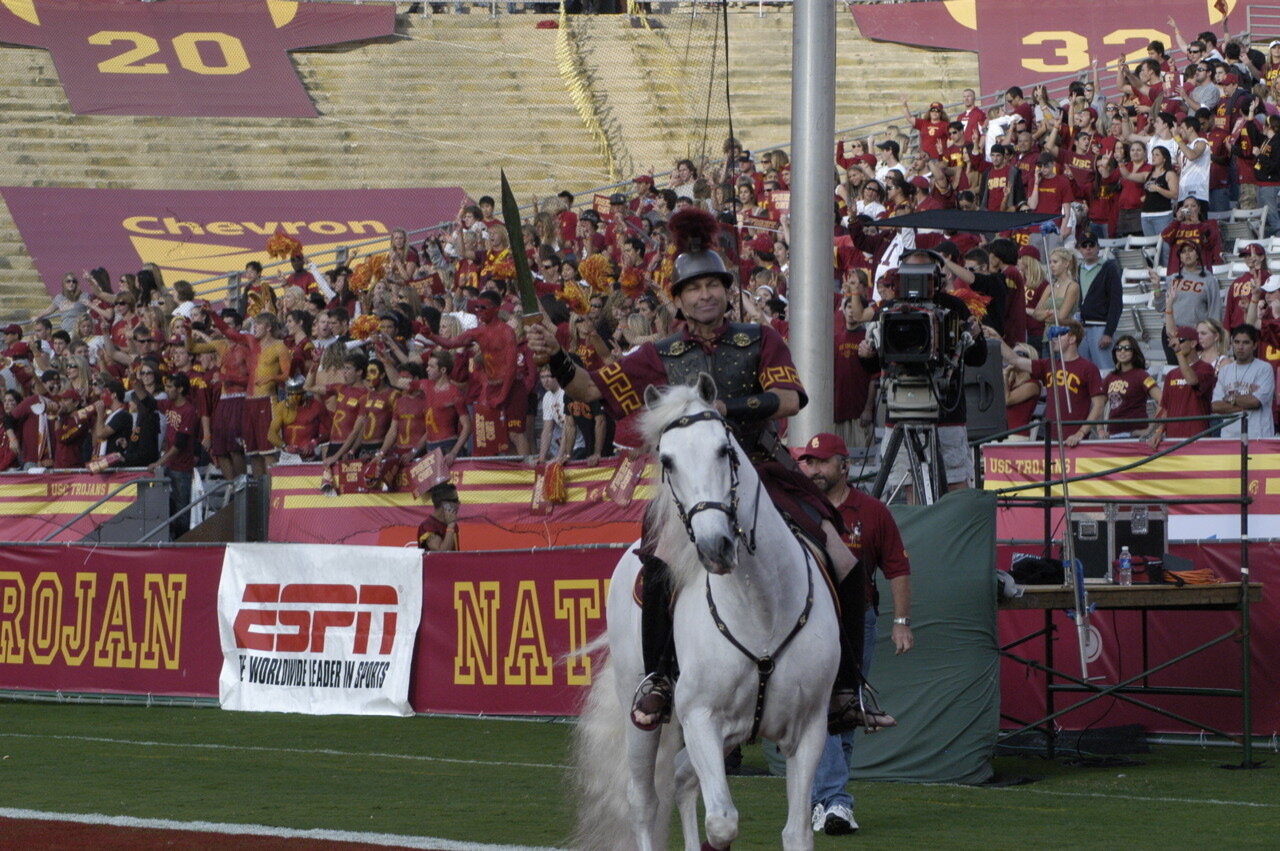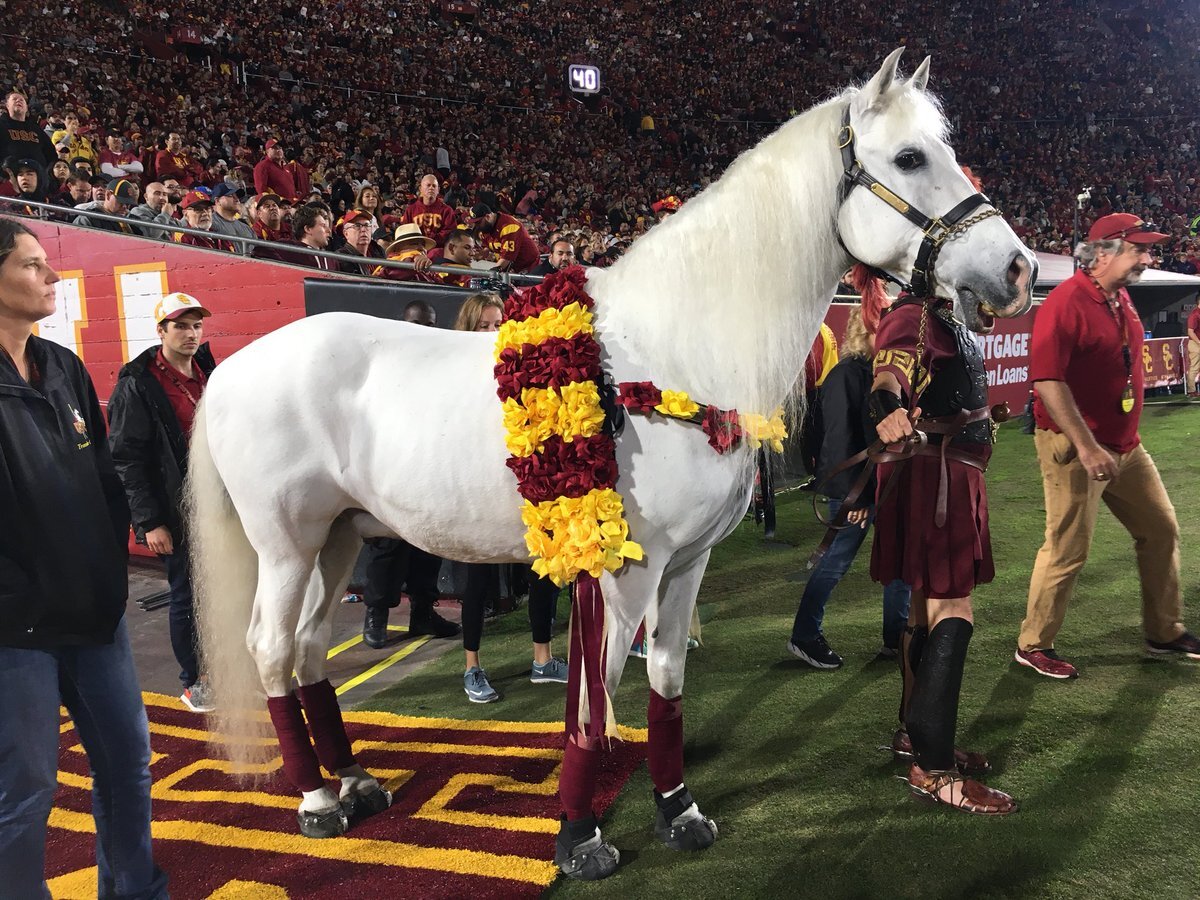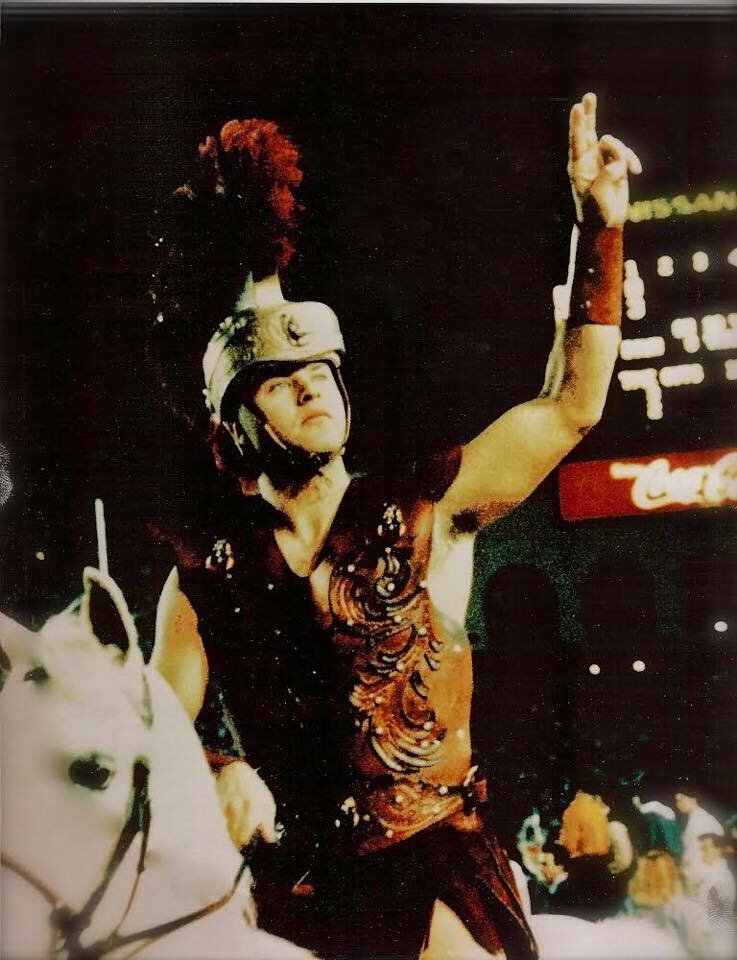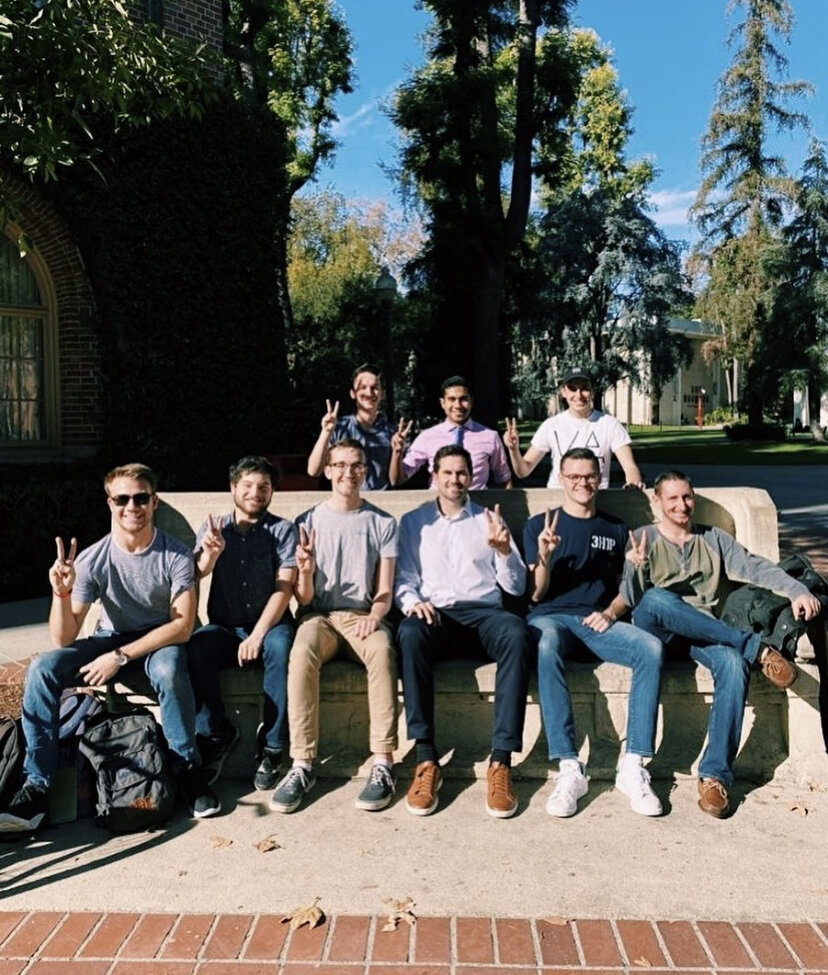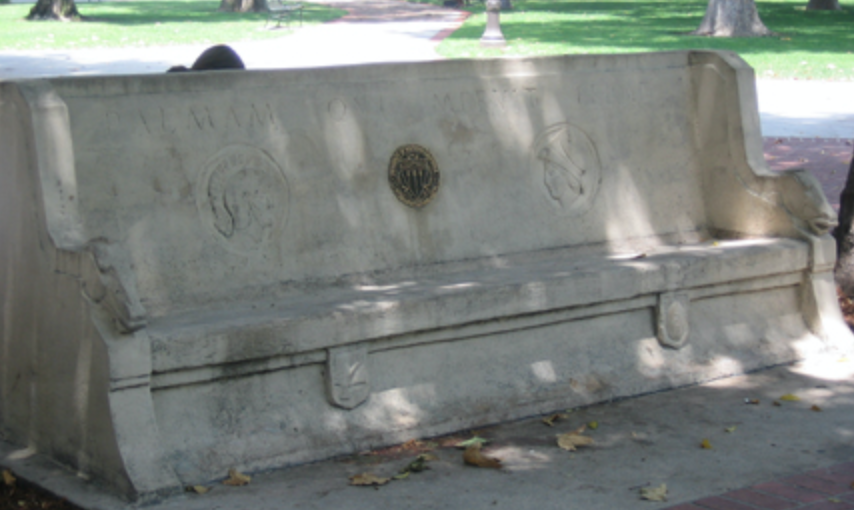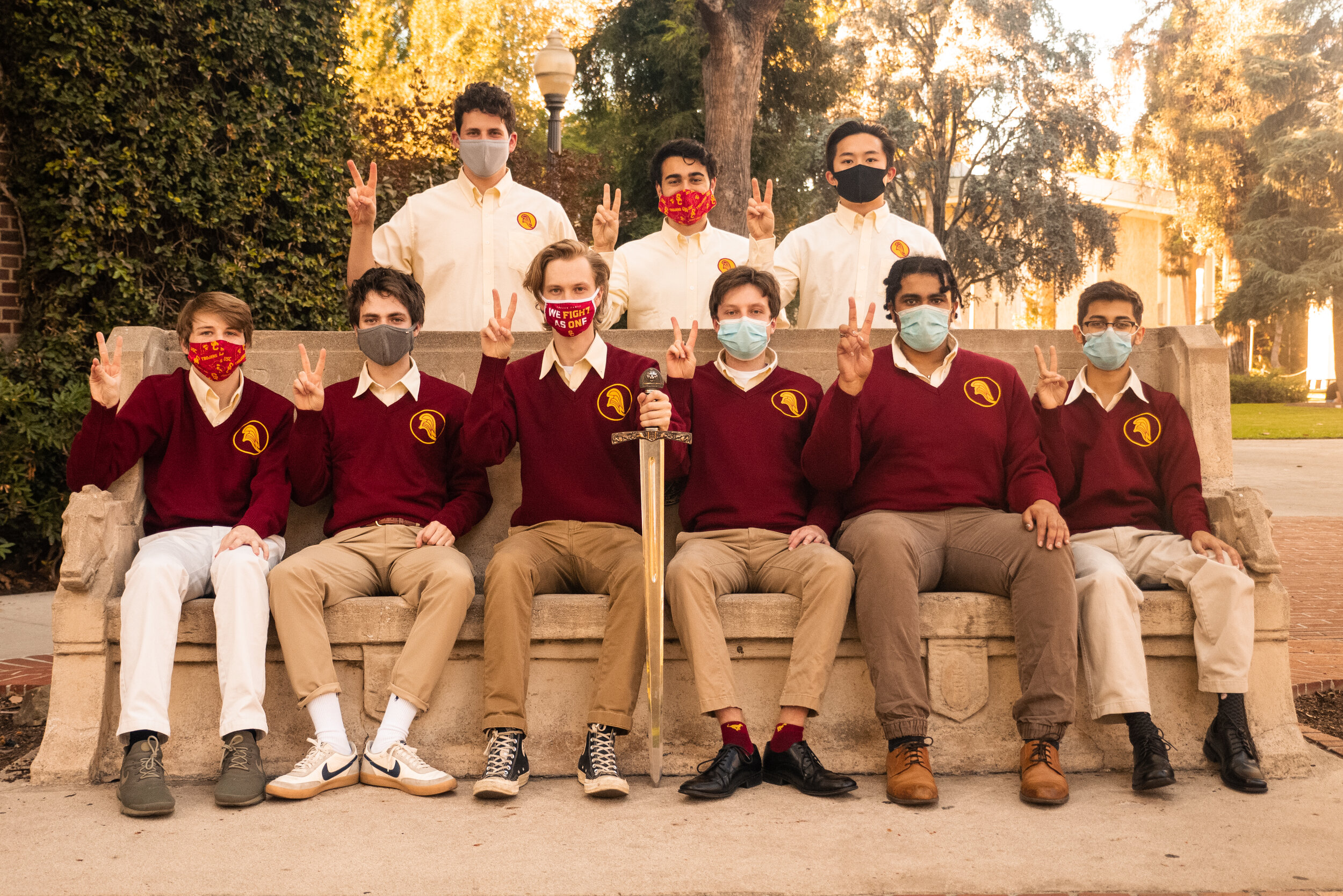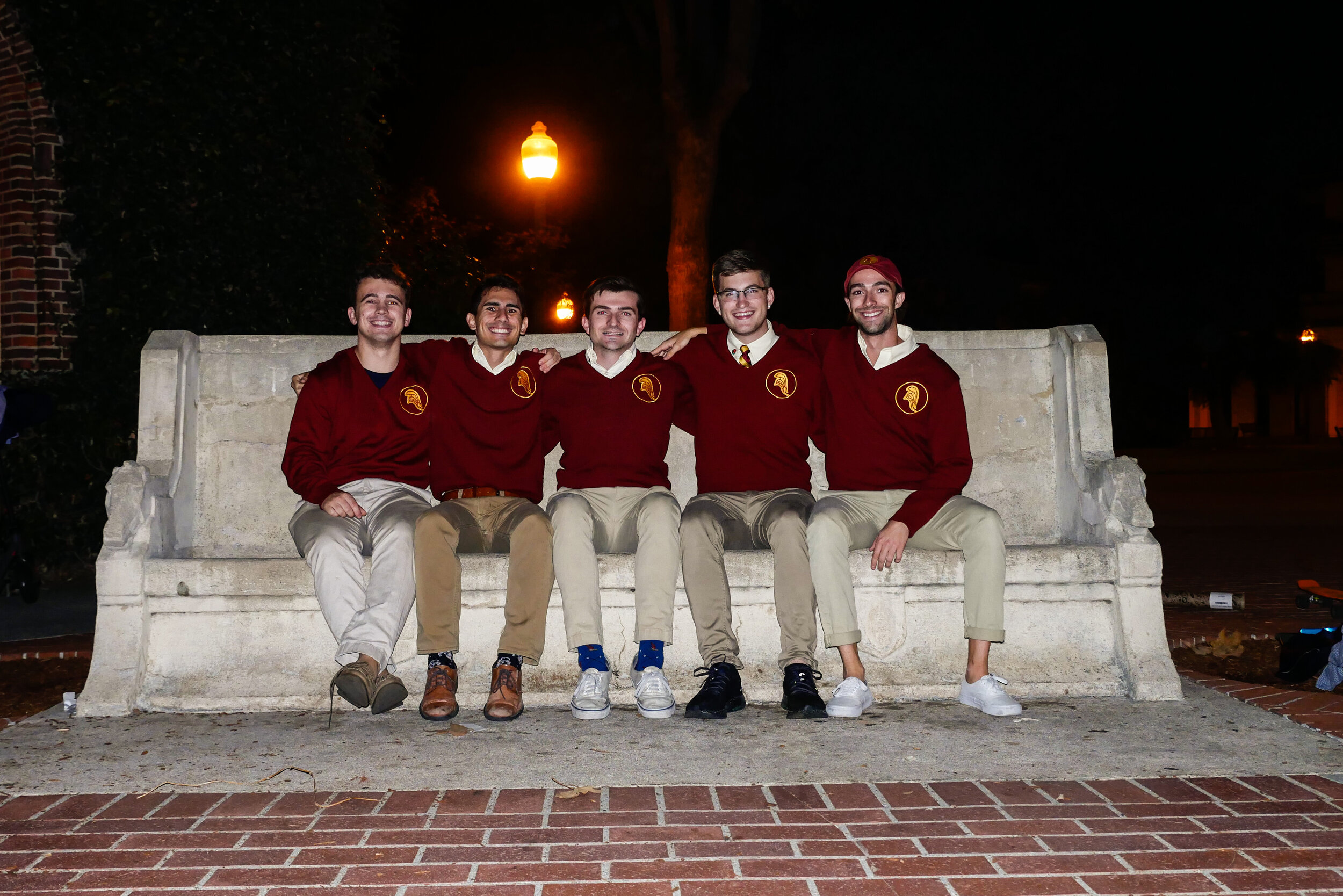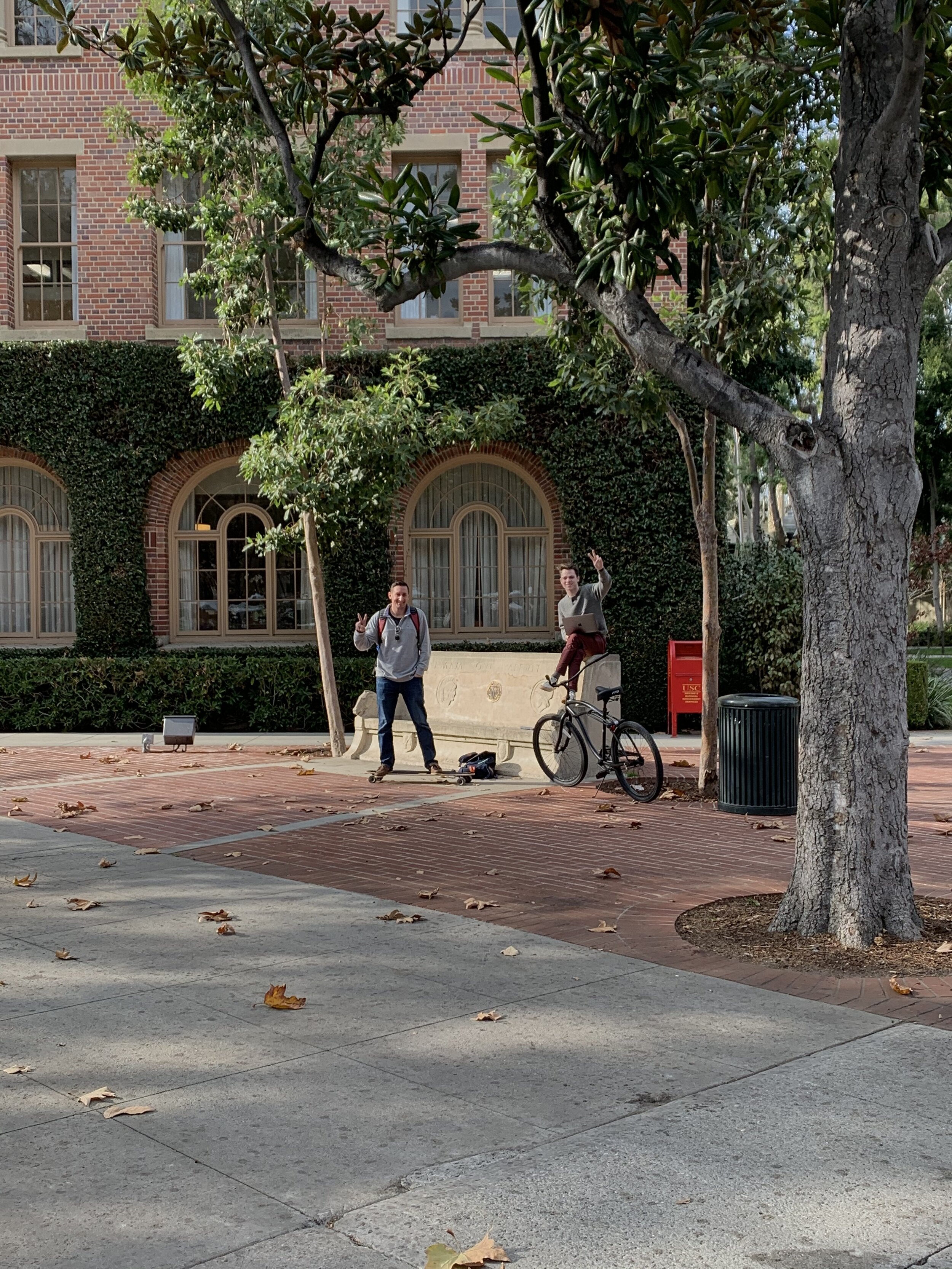Traditions
Founded in 1921 as the University’s Official Hosts, the Trojan Knights have served USC and its surrounding community with faith and energy, becoming a symbol for school service and spirit. Over the course of over a century now, the Knights have planned and executed some of the most important events in the history of USC, including Swim with Mike, card stunts, and escorting U.S. presidents. Today, the Trojan Knights are known for being the guardians of the Victory Bell, the protectors of Tommy Trojan during Troy Week, and the rambunctious crowd of body painters in the front row of every home football game.
We consider it an immense honor to attend the University of Southern California and continue to uphold the prestige and reputation of Cardinal and Gold through our organization’s three pillars: Brotherhood, Service, and Spirit. We ask that all Knights, new member and graduating seniors alike, fully embrace USC and all that it stands for.
We treasure USC’s past with our dedicated study of the university’s history. We value USC’s present with our continuous efforts to build spirit within the USC community as well as serve our surrounding community. Lastly, we strive to build a great USC future through upholding some of the university’s greatest traditions, including our very own Trojan Knights.
The Victory Bell
In 1939, UCLA was given a 295-pound bell from the UCLA Alumni Association. Originally from atop a Southern Pacific freight locomotive, the bell became a common sight at UCLA football games, as the Bruin cheerleaders began to ring it after each Bruin score.
At the beginning of the 1941 football season, 6 Trojan Knights infiltrated the UCLA cheering section and helped the Bruin students load the bell onto a truck bound for Westwood. While the Bruins went to get the key to the truck, they found that the Trojan Knights had removed the key and had driven off with the bell. The bell remained hidden for more than a year, where its location moving all across southern California.
After photos of the Bell appeared in a local student magazine, UCLA fans retaliated by painting Tommy Trojan, which incited a prank war between the two schools. Shortly thereafter, USC’s President at the time, threatened to cancel the USC-UCLA game if any other incidents happened. This ultimately led to the Victory Bell Accords of 1942.
On November 12, 1942, the student body presidents of both schools, USC’s Bill McKay and UCLA’s Bill Farrer, signed an agreement stating that the annual winner of the rivalry football game would keep possession of the bell for the following year. Since the bell became a rivalry trophy, its carriage has been painted both cardinal and blue several times over the years.
The Victory Bell can be seen every Game Day in the possession of the Trojan Knights. Before the game, the Trojan Knights ring the Victory Bell down Trousdale Boulevard. During games, we ring the Bell on the sidelines after every Trojan score, serving as an inspiration to all of the Trojan Family. We also have the privilege of bringing the bell to official University functions and events.
Tommy Watch
As has been the case since the early 1940s when UCLA students decided it would be fun to throw some paint on Tommy Trojan, the Trojan Knights have kept a careful 24/7 vigil during Troy Week, the week leading up to the UCLA game.
Our Knight’s eat, sleep, and live at Tommy Trojan for the week, always on the lookout for potential vandals. Knights look forward to spending the nights with Tommy, regardless of the weather, almost as much as the game itself. Nights are filled with great camaraderie amongst members who pass the time with capture the flag, football, and wiffleball match-ups under the watchful gaze of Tommy. Throughout the week, the whole USC community comes out to support us, with the Song Girls, Marching Band, football coaches, players, students, alumni, administrators, and more paying us all visits and thanks with food and words of encouragement. Our partner organization, the USC Helenes, similarly guard the Hecuba statue in the USC Village. Learn more about this tradition in this Pac-12 Network segment on Tommy Watch.
Body Painting
In the early 2000s, as card stunts started to phase out, Trojan Knights wanted to continue to support our great Trojan Football Team. We began to paint our chests to spell out creative words and phrases that would boost the morale of our team.
Our painted bodies have quickly become one of the most recognizable aspects of Trojan Athletics on gameday. We’ve been featured on ESPN’s College Gameday, live national television, and various social media and news outlets. This commitment also allows us to continue to reserve the first few rows of the student section.
By painting, we continue to uphold our pillar of Spirit, supporting our teams in any way we can. There’s nothing like walking over to the Coliseum painted in Cardinal and Gold with your fellow knights under the scorching Los Angeles sun. While painting originally began for football, we now paint for every sport!
Card Stunts
On October 21st, 1922 the Trojan Knights, under the leadership of Yell Leader Lindley Bothwell, created the first sequential card stunt with a record setting 500 cards. Cal and Stanford had been performing card stunts since the early 1900s, but the Knights created the world’s first moving card stunt at Bovard Field. In the following years, Knights created card stunts by hand on large sheets of graph paper. It was not until the 1960s that a computer program started to be utilized to create each stunt.
While in the USC “rooting section” students were required to wear white shirts in order to be a part of the card stunt. To keep the rooting section orderly and help organize the stunts, Knights were given two seats on the end of every aisle. In the early years, only one section was used for the stunt, but over the years we added another section, doubling our card stunt capacity.
In the late 1980s, card stunts disappeared from USC football games due to safety concerns over the thrown cards after the stunts. A number of attempts were made to bring stunts back in the 1990s and mid-2000s. In 2011 at the USC-UCLA game, card stunts made their triumphant return, with the use of a flexible, plastic card instead of the traditional hard plastic cards. Card stunts can be now be seen at the halftime of certain football games.
George Tirebiter
In the 1940s, a few Trojan Knights found a little stray dog wandering on Trousdale Parkway. The dog became known as George Tirebiter after he was repeatedly seen biting at the tires of cars driving down the street. George soon became a fan favorite from both the student body and the administration. At the height of his popularity in 1947, George became the first official mascot of the University of Southern California and the Knights were charged with keeping him. He even began leading out the Trojan Marching Band onto the field at football games, where he could be seen wearing little sweaters and hats. During one of the USC-UCLA games in the 1940s, George showed his true loyalty to the university when he bit UCLA’ s mascot Joe Bruin on the nose. Today, George Tirebiter is forever remembered at the South end of Trousdale Parkway, looking towards the Coliseum. If you are ever walking to the Coliseum on gameday, be sure to rub George on the nose for good luck.
Traveler
The Trojan Knights were also involved with the introduction of Traveler, the majestic white horse famously known as USC’s current mascot. If you walk down the heart of campus today, you will notice a statue of Traveler directly across from the statue of Tommy Trojan.
In 1954, before Traveler was ever introduced as the university’s official mascot, a Trojan Knight named Arthur J. Gontier III rode a white horse at a Trojan football game. Seven years later, inspired by that iconic Coliseum event and the advocacy of Trojan Knight Ed Tannenbaum, the university declared Traveler the official mascot of USC.
The Trojan Knights have even had one of their own members as a rider of Traveler, when Rick Oas took over the reigns in 1989. Traveler IX can still be seen riding around the Coliseum after the Trojans score a touchdown.
Trojan Knights Bench
The Trojan Knights Bench is one of the oldest pieces of architecture on campus, located directly outside the entrance to Bovard Auditorium in the heart of campus. The Bench was finished on April 30th, 1928 and was designed by architecture student Leland Thorne. While the bench was originally intended to be the “Senior Bench,” Trojan Knights led the project and eventually took over the bench as their own.
The Bench’s design includes iconography that represents the university. First, the University Seal is embedded in the center of the bench. The seal represents the university itself, but it also carries meaning. The three torches on the seal represent the three paths of learning: philosophy, science, and the arts. The Bench also includes reliefs of the goddess Minerva, representing wisdom, and a Trojan Warrior. On the base of the Bench are reliefs of a book and quill, representing learning, and a football representing the athletic history of our university. Finally, the armrests are shaped into horses, similar to Traveler.
The Bench also serves as our own special gathering spot on campus. At all hours of the day, you will find Knights hanging out at the Bench, eating lunch, doing homework, and enjoying each other’s company between classes.
The Bench represents everything that a Trojan Knight is. A Knight is wise, learned, ambitious, spirited, and most importantly, a Trojan to the end.


